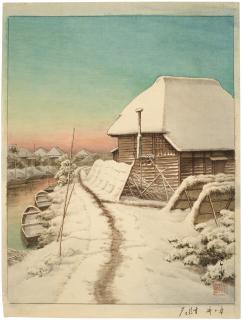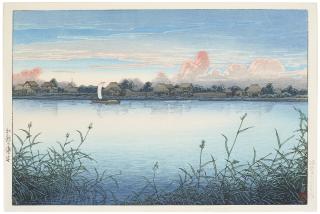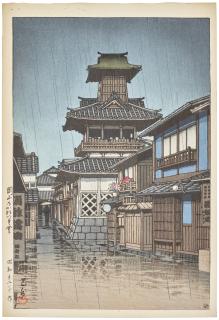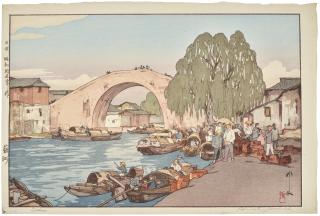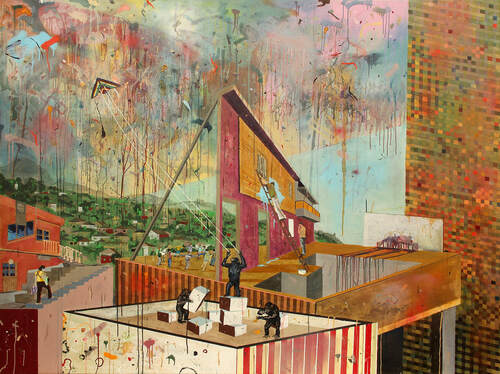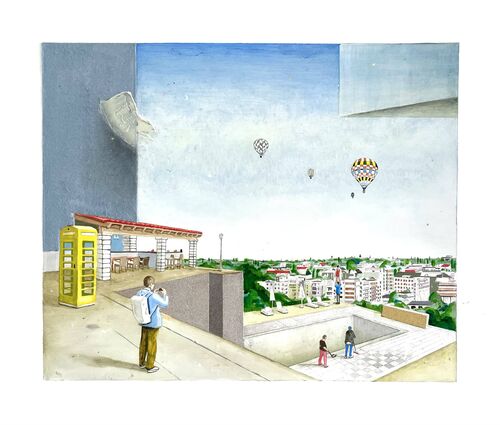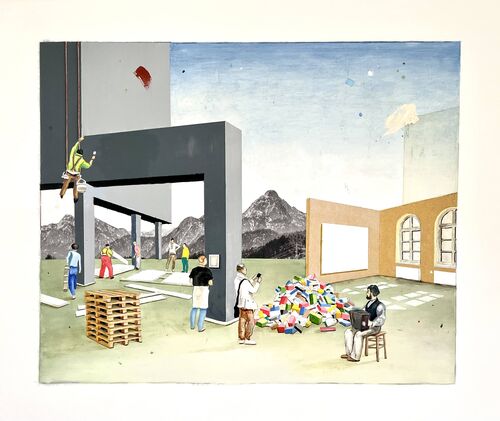Kawase Hasui Japanese, 1883 - 1957
The artist Kawase Hasui
- One of the most important and successful Japanese printmakers.
- Master of Japanese woodblock prints of the Shin Hanga movement.
- Snow scene prints are considered his best works.
The Japanese artist Kawase Hasui was born in Tokyo on 18 May 1883 under the name Bunjiro and learned Western painting styles such as certain watercolour and oil painting techniques as a child. At the age of 12 he was taught by the painter Aoyagi Bokusen, and at the age of 26 he deepened his knowledge of Western painting as a pupil of Okada Saburōsuke for two years. He then went to the workshop of Kaburagi Kiyokata, a master of the traditional Japanese school. Here he learned ukiyo-e, a Japanese genre of woodblock prints and paintings, as well as nihonga painting, a traditional style of Japanese painting. Kiyokata gave his student the name Hasui and introduced him to Watanabe Shōzaburō, the founder of the Shin Hanga movement. The latter became Hasui's publisher and their acquaintance turned into a lifelong collaboration that resulted in over 100 published woodblock prints.
Hasui was also a passionate traveller and produced various sketches and several watercolours on his excursions. These watercolours mainly depicted actors, everyday life and landscapes, many of which he published as illustrations in books and magazines. In 1920 Hasui designed his first print, which depicted snowfall. His subsequent snow scenes are considered the most original and best of his work.
In 1923, a fire following an earthquake destroyed all of Hasui's works and associated printing blocks that were in Watanabe. During his career as an artist, Hasui produced around 620 prints. Shortly before his death on 7 November 1957, his works were declared a national treasure by the Japanese government and he was honoured for his work. Today his works can be found in international museums, including the British Museum (London), the Brooklyn Museum (New York City), the Los Angeles County Museum of Art, the Metropolitan Museum of Art (New York City), the Museum of Fine Arts (Boston), the Nelson-Atkins Museum of Art (Kansas City), the Virginia Museum of Fine Arts (Richmond) and the Walters Art Museum (Baltimore).
Hasui's work is dominated by landscape and cityscape prints based on sketches and watercolours he made during his travels through Japan. His focus is primarily on creating atmosphere. Human figures are rarely to be found in his creations, but there is always a clear line in composition and effect. In addition to prints, sketches and watercolours, Hasui also produced oil paintings, traditional hanging scrolls and a few paravente (byōbu).
Der Künstler Kawase Hasui
- Gehört zu den bedeutendsten und erfolgreichsten japanischen Grafikern.
- Meister des japanischen Holzschnitts der Shin-Hanga-Bewegung.
- Schneeszenerien-Drucke gelten als seine besten Arbeiten.
Der japanische Künstler Kawase Hasui wurde am 18.05.1883 unter dem Namen Bunjiro in Tokio geboren und lernte schon als Kind westliche Malstile wie bestimmte Techniken der Aquarell- und Ölmalerei. Mit 12 Jahren wurde er vom Maler Aoyagi Bokusen unterrichtet und vertiefte seine Kenntnisse zur westlichen Malerei als 26-jähriger für zwei Jahre als Schüler von Okada Saburōsuke. Im Anschluss daran begab er sich in die Werkstatt von Kaburagi Kiyokata, einem Meister der traditionellen japanischen Schule. Hier lernte er ukiyo-e, eine japanische Gattung von Holzschnittdrucken und Gemälden sowie die Nihonga-Malerei, einen traditionellen Stil der japanischen Malkunst, kennen. Kiyokata verlieh seinem Schüler den Namen Hasui und stellte ihm Watanabe Shōzaburō, dem Gründer der Shin-Hanga-Bewegung, vor. Dieser wurde Hasuis Verleger und aus der Bekanntschaft eine lebenslange Zusammenarbeit, aus der über 100 verlegte Holzschnitte hervorgingen.
Zudem verreiste Hasui leidenschaftlich gern und fertigte auf seinen Ausflügen verschiedene Skizzen und mehrere Aquarelle an. Letztere bildeten vornehmlich Schauspieler, das Alltagsleben und Landschaften ab, von denen er viele als Illustrationen in Büchern und Magazinen veröffentlichte. 1920 designte Hasui seinen ersten Druck, auf dem Schneefall abgebildet war. Seine folgenden Schneeszenerien gelten als die originellsten und besten seiner Arbeiten.
Ein auf ein Erdbeben folgender Brand vernichtete 1923 alle Werke und dazugehörigen Druckstöcke Hasuis, die sich in Watanabe befanden. Während seiner Künstlerkarriere fertigte Hasui um die 620 Drucke. Kurz vor seinem Tode am 07.11.1957 wurden seine Werke von der japanischen Regierung zum Nationalheiligtum erklärt und er für sein Schaffen ausgezeichnet. Heute sind seine Arbeiten in internationalen Museen zu finden, darunter das British Museum (London), das Brooklyn Museum (New York City), das Los Angeles County Museum of Art, das Metropolitan Museum of Art (New York City), das Museum of Fine Arts (Boston), das Nelson-Atkins Museum of Art (Kansas City), das Virginia Museum of Fine Arts (Richmond) und das Walters Art Museum (Baltimore).
Hasuis Arbeiten sind bestimmt von Landschafts- und Stadtbilddrucken, die auf Skizzen und Aquarellen basieren, welche er während seiner Reisen durch Japan angefertigt hatte. Seinen Fokus setzt er dabei vor allem auf das Erschaffen von Atmosphäre. Menschliche Gestalten sind in seinen Werken nur selten zu finden, dafür aber immer eine klare Linie in Komposition und Wirkung. Neben Drucken, Skizzen und Aquarellen fertigte Hasui auch Ölgemälde, traditionelle hängende Schriftrollen und einige wenige Paravente (byōbu) an.
Kawase Hasui in a nutshell
In his almost 40 years of activity, Hasui has made about 620 different woodblock prints. They are characterized by high craftsmanship, obsession with detail and creative depiction of traditional themes. Especially his scenes in the snow, which he produced from 1920 onwards, are unparalleled. To this day, Hasui's works are highly sought after by collectors. Less known and also less numerous are Hasui's watercolors, oil paintings and painted screens (Byōbu).
One of the defining features of Kawase Hasui's art is his deep reverence for nature. His prints primarily focus on landscapes, particularly scenes of rural Japan, serene lakes, mountains, and tranquil countryside settings. Hasui masterfully captures the subtle nuances of light and atmosphere, allowing viewers to immerse themselves in the tranquility and natural beauty of each scene. His meticulous attention to detail and ability to convey a sense of calmness and serenity evoke a profound emotional response from the audience.
Hasui's compositions are carefully crafted, demonstrating his keen aesthetic sensibility. He skillfully combines elements of traditional Japanese art with his own unique style, creating balanced and harmonious compositions. His use of bold lines, intricate patterns, and carefully selected colors imbues his prints with a sense of visual depth and allure. Through his meticulous craftsmanship, Hasui captures the essence of each landscape, inviting viewers to embark on a visual journey and experience the tranquility of the natural world.
Woodblock printing is a traditional Japanese method that requires precision and expertise. Hasui's prints showcase his exceptional technical skills, from the intricate carving of the wooden blocks to the precise application of ink and the delicate layering of colors. His ability to create intricate textures and subtle gradations of color adds a sense of realism and depth to his prints, elevating them to a level of unparalleled craftsmanship.
Hasui often portrayed landscapes in different seasons, capturing the ephemeral beauty and ever-changing nature. Whether it is the vibrant colors of cherry blossoms in spring or the serene stillness of snow-covered landscapes in winter, his prints evoke a deep emotional resonance within the viewers. The changing seasons symbolize the transient nature of life and evoke a sense of nostalgia and contemplation, connecting viewers to the timeless beauty of nature.
Kawase Hasui's art continues to inspire and influence artists and enthusiasts worldwide. His prints have become highly sought-after collectibles, and his contributions to the art of woodblock printing have earned him a significant place in Japanese art history. Hasui's ability to convey the essence of Japan's natural landscapes with sensitivity and authenticity has left an enduring legacy, reminding us of the profound connection between art, nature, and the human spirit.
The woodblock print Zōjō-ji in the Snow (1925) is certainly Hasui's most famous image. It shows the snowed-in Buddhist temple Zōjō-ji in Tokyo, which was depicted, for example, on by Utagawa Hiroshige. In front of the temple, a young woman with an umbrella struggles through the snowdrifts. It is a typically atmospheric image by Hasui with lonely-looking people. The woodblock print was included in the list of valuable intangible cultural assets of Japan. Today, the Tokyo Tower is located in close proximity to the temple.
Both are art movements of Japanese woodblock printing that emerged and became predominant in the early 20th century. Artists adapted traditional themes of Japanese woodblock prints such as kabuki performers, birds, flowers, and elegant young women to their present, while incorporating Western design features such as perspective and shadow depictions. Shin-hanga, the movement to which Kawase Hasui belonged, means »new print«. It was especially popular outside Japan because of its modern depiction of traditional motifs. In terms of content, the followers of Sōsaku-hanga, the »creative print«, were freer. Here, the artists were concerned with a more personal representation of their experiences, and abstract prints, a complete novelty, were also invented. Furthermore, this direction differs from Shin-hanga in that the drawing, carving and printing were implemented by one person. Traditionally, three specialists each took on one of the tasks.
Häufige Fragen zu Kawase Hasui
In seiner fast 40-jährigen Tätigkeit hat Hasui circa 620 verschiedene Holzschnitt angefertigt. Sie zeichnen sich durch hohe handwerkliche Fähigkeiten, Detailversessenheit und kreative Darstellung traditioneller Themen aus. Vor allem seine Szenen im Schnee, die er ab 1920 fertigte. suchen ihresgleichen. Bis heute sind Hasuis Werke bei Sammlern sehr begehrt. Weniger bekannt und auch weniger zahlreich sind Hasuis Aquarelle, Ölgemälde und bemalte Wandschirme (Byōbu).
Eines der wichtigsten Merkmale der Kunst von Kawase Hasui ist seine tiefe Ehrfurcht vor der Natur. Seine Grafiken konzentrieren sich vor allem auf Landschaften, insbesondere auf Szenen des ländlichen Japans, ruhige Seen, Berge und beschauliche Landschaften. Hasui versteht es meisterhaft, die subtilen Nuancen von Licht und Atmosphäre einzufangen, so dass der Betrachter in die Ruhe und die natürliche Schönheit jeder Szene eintauchen kann. Seine akribische Liebe zum Detail und seine Fähigkeit, ein Gefühl der Ruhe und Gelassenheit zu vermitteln, rufen beim Publikum eine tiefe emotionale Reaktion hervor.
Hasuis Kompositionen sind sorgfältig ausgearbeitet und zeugen von seinem ausgeprägten ästhetischen Gespür. Er kombiniert gekonnt Elemente der traditionellen japanischen Kunst mit seinem eigenen einzigartigen Stil und schafft so ausgewogene und harmonische Kompositionen. Durch die Verwendung kühner Linien, komplizierter Muster und sorgfältig ausgewählter Farben verleiht er seinen Drucken ein Gefühl von visueller Tiefe und Faszination. Durch seine akribische Kunstfertigkeit fängt Hasui das Wesen jeder Landschaft ein und lädt den Betrachter ein, sich auf eine visuelle Reise zu begeben und die Ruhe der natürlichen Welt zu erleben.
Der Farbholzschnitt ist ein traditionelles japanisches Verfahren, das Präzision und Fachwissen erfordert. Hasuis Drucke zeigen seine außergewöhnlichen technischen Fähigkeiten, vom komplizierten Schnitzen der Holzblöcke bis hin zum präzisen Auftragen der Tinte und der zarten Schichtung der Farben. Seine Fähigkeit, komplizierte Texturen und subtile Farbabstufungen zu schaffen, verleiht seinen Drucken ein Gefühl von Realismus und Tiefe und hebt sie auf ein Niveau unvergleichlicher Handwerkskunst.
Hasui porträtierte oft Landschaften in verschiedenen Jahreszeiten, um die vergängliche Schönheit und die sich ständig verändernde Natur einzufangen. Ob es nun die leuchtenden Farben der Kirschblüten im Frühling oder die ruhige Stille der verschneiten Landschaften im Winter sind, seine Grafiken rufen beim Betrachter eine tiefe emotionale Resonanz hervor. Die wechselnden Jahreszeiten symbolisieren die vergängliche Natur des Lebens und rufen ein Gefühl von Nostalgie und Kontemplation hervor, das den Betrachter mit der zeitlosen Schönheit der Natur verbindet.
Die Kunst von Kawase Hasui inspiriert und beeinflusst weiterhin Künstler und Kunstliebhaber weltweit. Seine Grafiken sind zu begehrten Sammlerstücken geworden, und seine Beiträge zur Kunst des Farbholzschnitts haben ihm einen bedeutenden Platz in der japanischen Kunstgeschichte eingebracht. Hasuis Fähigkeit, das Wesen der japanischen Naturlandschaften mit Sensibilität und Authentizität zu vermitteln, hat ein bleibendes Vermächtnis hinterlassen, das uns an die tiefe Verbindung zwischen Kunst, Natur und dem menschlichen Geist erinnert.
Der Holzschnitt Zōjō-ji im Schnee (1925) ist sicher Hasuis berühmteste Darstellung. Es zeigt den eingeschneiten buddhistischen Tempel Zōjō-ji in Tokio, der zum Beispiel auf von Utagawa Hiroshige abgebildet wurde. Vor dem Tempel kämpft sich eine junge Frau mit Schirm durch die Schneeverwehungen. Es ist ein typisch atmosphärisches Bild von Hasui mit einsam wirkenden Menschen. Der Holzschnitt wurde in die Liste wertvoller immaterieller Kulturgüter Japans aufgenommen. Heute befindet sich in direkter Nähe zum Tempel der Tokyo Tower.
Beides sind Kunstrichtungen des japanischen Holzschnitts, die zu Beginn des 20. Jahrhunderts entstanden und vorherrschend wurden. Traditionelle Themen des japanischen Holzschnitts wie Kabuki-Darsteller, Vögel, Blumen und elegante junge Frauen passten die Künstler an ihre Gegenwart an und ließen westliche Gestaltungsmerkmale wie Perspektive und Schattendarstellungen einfließen. Shin-hanga, der Bewegung, der Kawase Hasui angehörte, bedeutet »Neuer Druck«. Sie war besonders außerhalb Japans wegen der modernen Darstellung traditioneller Motive beliebt. Inhaltlich freier waren die Anhänger von Sōsaku-hanga, dem »kreativen Druck«. Hier ging es den Kunstschaffenden um eine persönlichere Darstellung ihres Erlebten und auch abstrakte Drucke, eine völlige Neuheit, wurden erdacht. Weiterhin unterscheidet diese Richtung sich von Shin-hanga darin, dass die Zeichnung, das Schnitzen und das Drucken von einer Person umgesetzt wurden. Traditionellerweise übernahmen drei Spezialisten je eine der Aufgaben.




